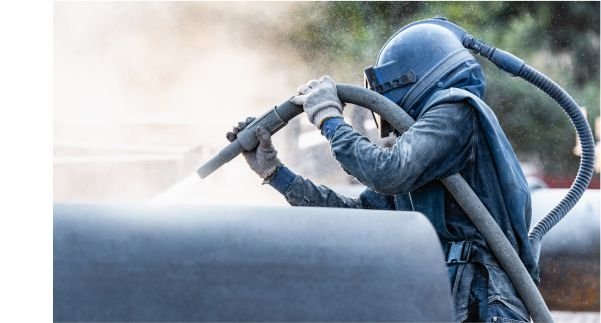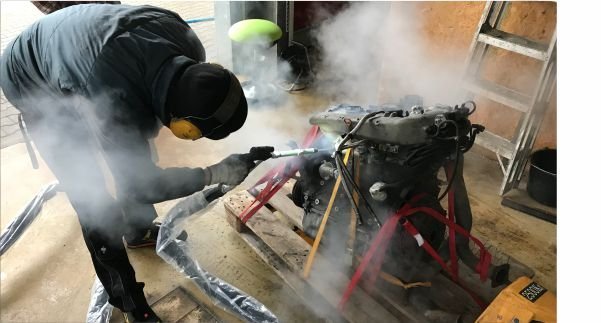 Made in Slovakia
Made in Slovakia ISO 9001
ISO 9001 Made in Slovakia
Made in Slovakia ISO 9001
ISO 9001
Blasting equipment is extensively used in various industrial sectors – in shipbuilding for cleaning ship hulls and preparing them for painting, in the automotive industry for cleaning gearboxes, connecting rods, engine components, etc., in aviation, in the rubber industry for cleaning and preparing steel surfaces, for cleaning and preparing profiles for painting, for cleaning moulds, for mechanically removing limescale etc.
The choice of surface treatment technology depends on the specific conditions (e.g. the shape and size of the object, the degree of damage, the thickness of the layer to be removed, and the quality of the base being prepared). Sandblasting is one of the most commonly used base preparation methods. However, dry ice blasting is a more ecological and effective alternative.
Sandblasting (also known as abrasive blasting) is a surface treatment process that uses a motor-driven machine – usually an air compressor – and a sandblasting machine. When the grains of sand hit the surface, they create a smoother and more even texture. The base preparation ends with the creation of a cohesive, clean, and relatively rough surface to which new layers adhere well.
It is an effective way to remove paint, limescale, rust, and other coatings from surfaces. The sandblasting process is relatively easy. It can be used to clean almost any material; however you need proper knowledge of the types of materials to be sandblasted. The disadvantages of sandblasting are primarily the risk of surface damage – sandblasting using silica sand is extremely abrasive, meaning you can damage the base if you are not careful; safety – because sand is used, this process is responsible for causing lung diseases like silicosis; while another problem is that the material needs to be cleaned of impurities (greases) so that it does not unnecessarily contaminate the abrasive. Greasy material needs to be degreased as grease reduces the effectiveness and fineness of the abrasive. The grains clump together and block the lines.
 Cleaning – dry ice blasting is a modern, ecological, non-abrasive industrial cleaning method. The cleaning process uses three basic factors: kinetic energy, thermal shock, and sublimation. The process only results in the removed contaminant, and there is no secondary waste, unlike with e.g. sandblasting. This means that cleaning with dry ice is effective, gentle on the material being cleaned, and environmentally friendly. Using dry ice you can ecologically and gently remove deposits, contaminants, or surface rust without needing to disassemble the equipment being cleaned, thus saving time and significant costs. Dry ice also inhibits bacteria growth, and the dry ice cleaning process stops the growth of fungi and spores, and reduces contamination from other biological substances. In addition, it is non-toxic, odourless, and suitable for all surfaces – from metal, wood and concrete, to delicate wood structures, glass and textiles.
Cleaning – dry ice blasting is a modern, ecological, non-abrasive industrial cleaning method. The cleaning process uses three basic factors: kinetic energy, thermal shock, and sublimation. The process only results in the removed contaminant, and there is no secondary waste, unlike with e.g. sandblasting. This means that cleaning with dry ice is effective, gentle on the material being cleaned, and environmentally friendly. Using dry ice you can ecologically and gently remove deposits, contaminants, or surface rust without needing to disassemble the equipment being cleaned, thus saving time and significant costs. Dry ice also inhibits bacteria growth, and the dry ice cleaning process stops the growth of fungi and spores, and reduces contamination from other biological substances. In addition, it is non-toxic, odourless, and suitable for all surfaces – from metal, wood and concrete, to delicate wood structures, glass and textiles.
Blasting with dry ice means there is no need to collect the used media. The dry ice evaporates upon contact with the surface, leaving only the unwanted coating and/or contaminants. Dry ice blasting therefore gives the operator the luxury of blasting surfaces practically anywhere.
SUMMARY:
Blasting with sand or other abrasive elements (glass or plastic granulate) damages the surfaces of the cleaned parts and shortens their service life.
Dry ice pellets are non-abrasive and extremely gentle on the cleaned surface.
Any blasting media that is not removed can significantly impact the production process. Dry ice pellets immediately evaporate during the cleaning process, negating this risk.
Blasting residues require separate disposal and often costly treatment.
Dry ice cleaning does not generate any secondary waste – the dry ice immediately sublimes.